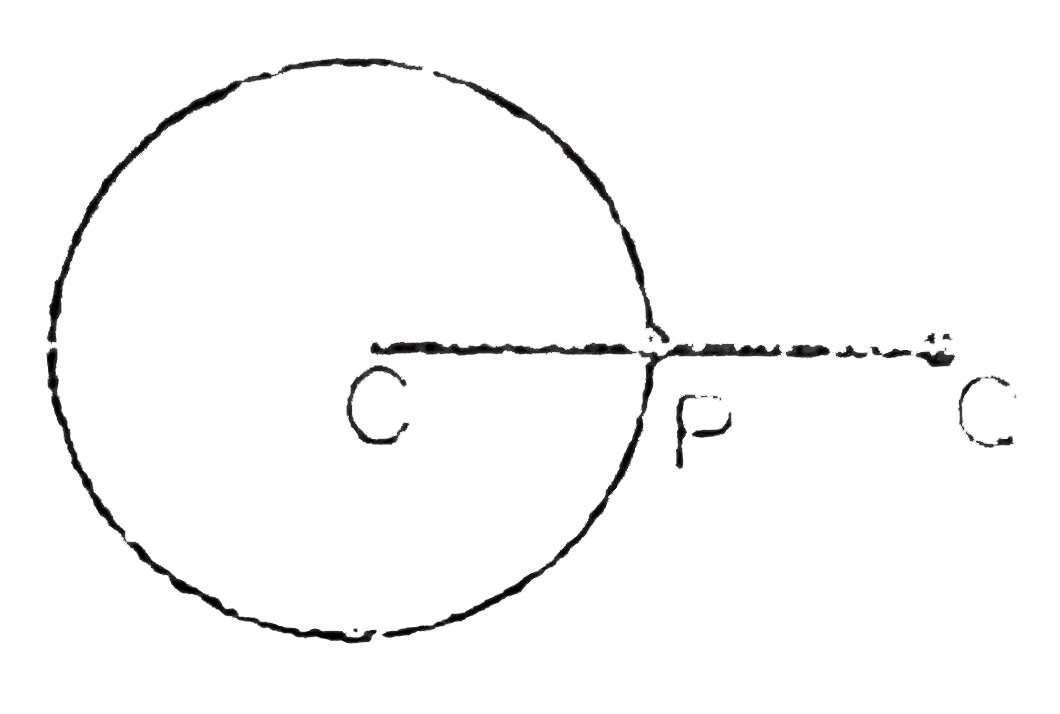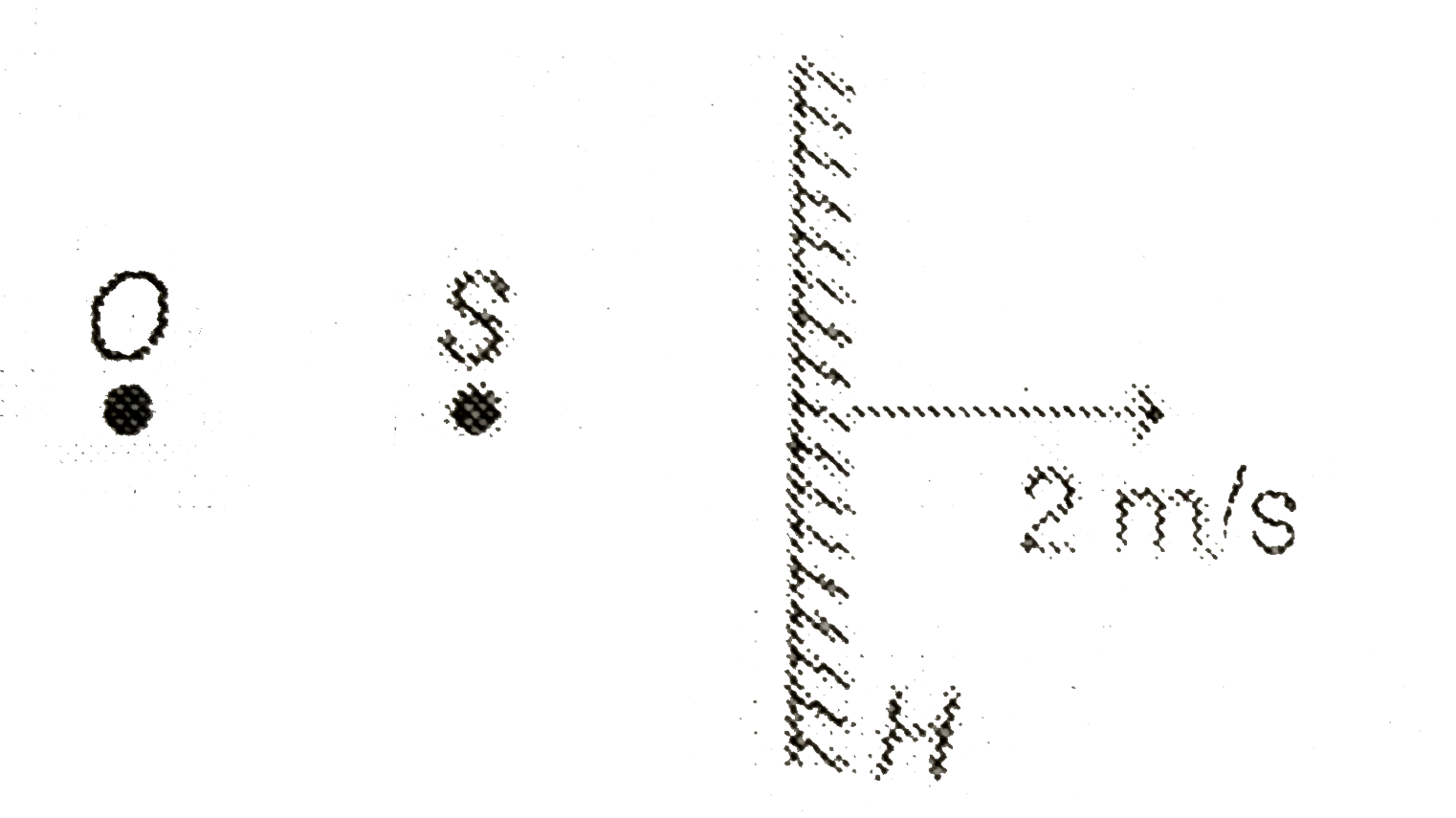
A source of sound and detector are arranged as shown in Fig. The detector is moving along a circle with constant angular speed ω. It start from the shown location in anticlockwise direction at t=0
(Take velocity of sound in air as v)
What is the frequency as received by detector, when it rotates by an angle π2?
f
v−ωRv×f
v−ωRv×f
v−ωR×2√5v×f
The correct Answer is:D

The location of detector at required instant is shown in Fig.
We have, v0=Rω
fap=v−v0cosθv×f
cosθ=2R√5R
fap=v−ωR×2√5v×f
Topper's Solved these Questions
- SOUND WAVES AND DOPPLER EFFECTBOOK - CENGAGE PHYSICSCHAPTER - SOUND WAVES AND DOPPLER EFFECTEXERCISE - Integer
16 Videos
- SOUND WAVES AND DOPPLER EFFECTBOOK - CENGAGE PHYSICSCHAPTER - SOUND WAVES AND DOPPLER EFFECTEXERCISE - Assertion-Reasoning
24 Videos
- RIGID BODY DYNAMICS 2BOOK - CENGAGE PHYSICSCHAPTER - RIGID BODY DYNAMICS 2EXERCISE - Interger
2 Videos
- SUPERPOSITION AND STANDING WAVESBOOK - CENGAGE PHYSICSCHAPTER - SUPERPOSITION AND STANDING WAVESEXERCISE - Comprehension Type
5 Videos
Similar Questions
A source of sound with natural frequency v0 moves uniformly along a straight line separated from a stationary observer by a distance l . The velocity of the source is equal to η fraction of velocityof sound. Find the frequency of sound received by the observer at the moment when the source gets closest to him and also find the distance between the source and the observer at the moment, when the observer receives a frequency v=v0
View SolutionA source of sound emitting a 1200 Hz note travels along a straight line at a speed of 170ms−1. A detector is placed at a distance of 200 m from the line of motion of the source. (a) Find the frequency of sound received by the detector at the instant when the source gets closest to it. (b) Find the distance between the source and the detector at the instant it detects the frequency 1200 Hz. Velocity of sound in air=340ms−1.
View Solution
Knowledge Check

A source of sound and detector are arranged as shown in Fig. The detector is moving along a circle with constant angular speed ω. It start from the shown location in anticlockwise direction at t=0
(Take velocity of sound in air as v)
Find the time interval between minimum and maximum frequency as received by the detector.Aπ(3ω)B5π(3ω)C4π(3ω)Dπω
A source of sound and detector are arranged as shown in Fig. The detector is moving along a circle with constant angular speed ω. It start from the shown location in anticlockwise direction at t=0
(Take velocity of sound in air as v)
Q. Find the time at which the detector will hear the maximum frequency for the first time.Aπ(3ω)B5π(3ω)C4π(3ω)Dπω
A source of sound and detector are moving as shown in Fig. at t=0. Take velocity of sound wave to be v. For this situation mark out the correct statement(s).AThe frequency received by the detector is always greater than f0BInitially, frequency received by the detector is greater than f0, becomes equal to f0, and then decreases with the time.CFrequency received by the detector is equal to f0 at t=dcotθ0(2v0).DFrequency received by the detector can never be equal to f0
A source of sound is rotating in the anticlockwise direction on a circle of radius 3 m, with an angular velocity of 10 rad s−1, given the frequency of the sound produced is 340 Hz and the velocity of sound is 330m s−1. The maximum frequency heard by the observer in the plane of the circle at a large distance will be

View SolutionAn electron is at P t=0 It is circulating in anticlockwise direction with a constant angular speed ω along the shown circular path. Magnetic field at Q(CQ=2R, where R is radius of the circular) will be recorded as zero at times)

View SolutionA stationary sound sound 's' of frequency 334 Hz and a stationary observer 'O' are placed near a reflecting surface moving away from the source with velocity 2 m/s as shown in the figure. If the velocity of the sound waves is air is v= 330 m/s the apparent frequency of the echo is

View Solution
A source of sound and a detector are placed at the same place on ground At t=0, the source S is projected towards reflector with velocity v0 in vertical upward directon and reflector starts moving down with constant velocity v0 At t−0, the vertical separation between the reflector and source is H(>v202g). The speed of sound in air is v(>>v0), Take f0 as the frequency of sound waves emitted by source. Based on above information answer the following questions.
Q. Frequency of sound received by detector after being reflected by reflector at t=v02g is
View Solution
A source of sound and a detector are placed at the same place on ground At t=0, the source S is projected towards reflector with velocity v0 in vertical upward directon and reflector starts moving down with constant velocity v0 At t−0, the vertical separation between the reflector and source is H(>v202g). The speed of sound in air is v(>>v0), Take f0 as the frequency of sound waves emitted by source. Based on above information answer the following questions.
Q. Wavelength of sound waves as received by detector before reflection at t=v02g is
View Solution
